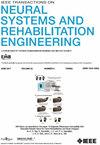Changes in Kinematic and Spatiotemporal Gait Parameters With a Biarticular Lower Limb Exosuit for Adolescents With Crouch Gait During Level Walking and Stair Climbing
IF 4.8
2区 医学
Q2 ENGINEERING, BIOMEDICAL
IEEE Transactions on Neural Systems and Rehabilitation Engineering
Pub Date : 2025-02-19
DOI:10.1109/TNSRE.2025.3543606
引用次数: 0
Abstract
Crouch gait is a prevalent walking abnormality among children with cerebral palsy, characterized by excessive knee and hip flexion during walking. This condition often limits children’s engagement in physical activities and daily life. Current exoskeleton solutions targeting the knee joint in this population are either tethered or bulky, hindering practical integration into daily routines. In this cross-sectional study, we evaluated the impact of a biarticular cable-driven exosuit, originally designed for adults, on the gait pattern of adolescents with crouch gait. Participants completed level walking and stair climbing trials under three conditions: without the exosuit (noMyo), with the exosuit inactive (MyoOff), and with the exosuit active (MyoOn). Kinematic and spatiotemporal gait metrics were analyzed using 3D motion capture. Five male adolescents with mild to moderate crouch participated. Results revealed significant improvements in mean knee and hip extension during the assisted phase (5 to 50% of the gait) with MyoOn compared to noMyo, increasing by 6 (range: 0 - 12) and 12 (range: 4 - 24) degrees, respectively, during level walking. During stair climbing, knee and hip extension improved in the stance phase of the trailing leg in the MyoOn condition compared to MyoOff. Only the hip angles improved in the MyoOn condition compared to noMyo. Spatiotemporal metrics showed no improvement. Stride length shortened significantly in both MyoOn and MyoOff. These findings demonstrate the exosuit’s potential to address extension deficits in crouch gait, although its weight may limit improvements in spatiotemporal gait characteristics. Developing a lighter, child-specific version could expand accessibility to a broader pediatric population.双关节下肢外套对青少年蹲伏行走和爬楼梯过程中运动学和时空步态参数的影响
克劳奇步态是脑瘫儿童中常见的一种行走异常,其特征是行走时膝关节和髋部过度弯曲。这种情况经常限制儿童参与体育活动和日常生活。目前针对这一人群的膝关节的外骨骼解决方案要么系住,要么体积庞大,阻碍了实际融入日常生活。在这项横断面研究中,我们评估了一种最初为成人设计的双关节电缆驱动外骨骼服对青少年蹲姿步态模式的影响。参与者在三种情况下完成了水平行走和爬楼梯的试验:不穿外套(noMyo)、不穿外套(MyoOff)和穿外套(MyoOn)。采用三维运动捕捉技术分析步态的运动学和时空特征。5名轻度至中度蹲伏的男性青少年参与了研究。结果显示,与noMyo相比,MyoOn在辅助阶段(步态的5 - 50%)的平均膝关节和髋关节伸展度显著改善,在水平行走期间分别增加了6度(范围:0 - 12度)和12度(范围:4 - 24度)。在爬楼梯过程中,与MyoOff相比,MyoOn条件下的后腿站立阶段的膝关节和髋关节伸展得到改善。与noMyo相比,MyoOn的情况下只有髋关节角度有所改善。时空指标没有改善。MyoOn和MyoOff的步幅都明显缩短。这些研究结果表明,尽管其重量可能限制了时空步态特征的改善,但外骨骼衣在解决蹲伏步态伸展缺陷方面的潜力。开发一个更轻的、针对儿童的版本可以扩大更广泛的儿科人群的可访问性。
本文章由计算机程序翻译,如有差异,请以英文原文为准。
求助全文
约1分钟内获得全文
求助全文
来源期刊
CiteScore
8.60
自引率
8.20%
发文量
479
审稿时长
6-12 weeks
期刊介绍:
Rehabilitative and neural aspects of biomedical engineering, including functional electrical stimulation, acoustic dynamics, human performance measurement and analysis, nerve stimulation, electromyography, motor control and stimulation; and hardware and software applications for rehabilitation engineering and assistive devices.

 求助内容:
求助内容: 应助结果提醒方式:
应助结果提醒方式:


